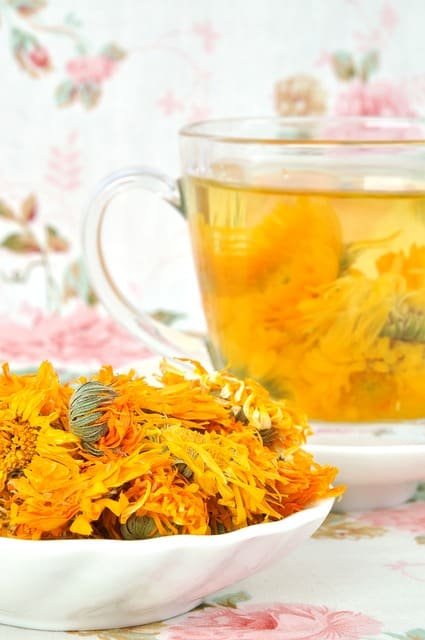
There are about 30 species of chrysanthemum, their petals are edible and they are prepared in the form of tea. It is a plant with small yellow or white flowers and they are edible in Asia. Its flavor is like mustard and the toothed leaves have a strong flavor. In this post you will learn how to make chrysanthemum tea taste good.
The Chinese consume the chrysanthemum plant to treat headaches and in food as a seasoning to give length of life. According to its nutritional content, it promotes longevity, thanks to its antioxidant properties, fiber, protein, potassium, vitamin A and C.
1. How to make chrysanthemum tea taste good. stems and leaves
The chrysanthemum plant is perishable, therefore it should be consumed as soon as possible. Although it is possible to keep it for longer, keeping it in bags in the fridge for a maximum time of 5 days, in the case of loose stems or the entire plant.
The flavor of stems and leaves is intense, with a certain bitterness, something similar to that of mint. The more developed the plant is, the more bitter it is. In the case of the flowers, they are also bitter, although not so much, their flavor is rather delicate. They are also used to decorate dishes. The stems, flowers and leaves can be included in salads or cooked, for example, in blanched or sautéed vegetables, omelettes, stews, etc. Of course, cooking should not be done for a long time so that its properties can be used.
2. Chrysanthemum tea
Another way to know how to make chrysanthemum tea taste better is by preparing it as an infusion. The chrysanthemum tea prepared with dried flowers it is widely consumed in China and Japan, although it is also included in food and beverages. It has a mild flavor like chamomile tea, but with a golden coloration. It is an excellent alternative to coffee, black tea and green tea to calm the nerves, because it does not contain caffeine.
The flowers and leaves are also used to prepare tizanas against stress, insomnia and anxiety. The roots are often used boiled to relieve headaches. In addition, it has a cooling effect on the body, especially in people who have suffered from heat stroke or indigestion.
Its preparation is simple, dehydrated flowers of the plant are used (chrysanthemum leaves can be dried in a food dehydrator). It is prepared as follows:
- Boil 250 milliliters of water.
- When it starts to boil add 3 grams of flowers of chrysanthemums
- Lower the heat and let cook for a minute.
- After the time has elapsed, it is turned off and allowed to infuse for about 10 minutes.
- It is recommended to drink a maximum of 2 cups a day.
Drinking chrysanthemum tea is safe, but it discourages consume it in people who are allergic to daisies and ragweed. It is also not recommended for pregnant women, lactating women or diabetics to drink it.
3. How to make chrysanthemum tea taste good. Varieties of Chrysanthemums
Among the varieties of chrysanthemums is the chrysanthemum coronarium, also called mirabelles or coronaria. It can measure up to 90 cm tall and comes from the Mediterranean. Its leaves are light green. Its flowers resemble those of yellow daisies or with white parts. In oriental cuisine, its stems and young shoots are used as vegetables and it bears the name of shungiku or chop suey. There is also the indicum variety that is used as a medicinal plant, its young leaves are usually included in vegetables, its flowers in vinegar
And added to salads, giving it a slightly bitter taste. This variety is often used to protect other species and prevent the formation of caterpillars or earthworms, its repellent properties make it ideal.
4. How to make chrysanthemum tea taste good. Xiaolan small olive tree
Coming from the Chinese town of Xiaolan, in the Pearl River Delta, its history dates back to the 13th century. Xiaolan chrysanthemum flowers are used in many popular dishes, including congee, luncheon meat, and hot pot. Its inhabitants are not only limited to these preparations, they also have skills to do it in banquets and in the manufacture of chrysanthemum liquor.
November is very colorful for this town as people decorate the roads at the annual chrysanthemum fair. All gardens with this plant stand out in beauty and variety.
5. The taste of chrysanthemum in Japan

In Japan, before their flowers grow, due to their freshness, citrus and menthol touches are used in salads. Its blanched stems are used in sashimi, sandwiches, soups, tortillas, and even sweet or savory biscuits. Another way to make chrysanthemum tea taste better is by pickling its flower buds in soy sauce. It is also used to flavor pasta, desserts, vegetable pates or stews. To avoid its bitter taste, it is usually scalded or finely chopped to add it to stews, thus achieving a dish with a lot of aroma and flavor.
The chrysanthemum plant contains antioxidants (flavonoids, linarin, and anthocyanins) that reduce free radicals, inhibit the growth of cancer cells, and are anti-inflammatory. It also has antipyretic, antiallergic, antihypertensive and sedative properties. Chrysanthemum tea improves vision, helps reduce cataracts or blurred vision. It is recommended for people who work a long time with the computer, because it relaxes the eyes.
